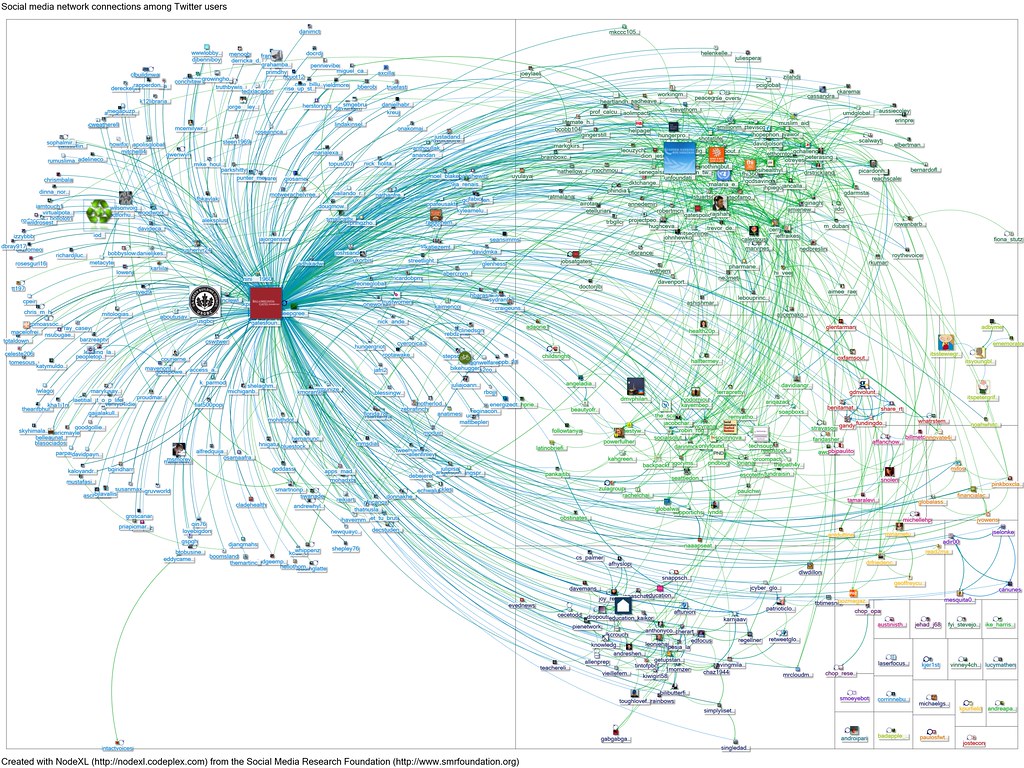The Twitter network below was created by Marc Smith, Social Media Research Foundation. He used it in a recent workshop on Social Media Network Analysis that I organized here at Syracuse University on January 19-20. I picked it up and posted it here on my Social Media in the Public Sector blog, because it relates to the Global Health Advocacy and Policy Project (GHAPP), PI Jeremy Shiffman (American University). It is a Gates-funded project I’m involved in to study the global public health issue networks. From the project website:
The team is investigating six global health policy communities — networks of individuals and organizations linked by a shared concern for a public health issue. The aim is to develop generalizable knowledge concerning why some networks are more effective than others in generating resources and attention, facilitating national policy adoption and supporting the scale-up of interventions.
This specific Twitter network was created by Marc Smith tracking the keyword “gatesfoundation” among Twitter users on January [Please visit Marc Smith’s Flickr page with a full description of the process and statistic]. It shows Twitter users who have actively chosen “gatesfoundation” either as a hashtag in their tweets, retweeted a message from the @gatesfoundation Twitter account or mentioned other users’ messages. In our workshop, Marc used the Gates Foundation Twitter network as a way to contrast two different types of networks: brand networks vs. broadcasting networks.
The brand network, where many Twitter users are over and over using and re-using the same keyword independent of each other, results in a tight knit community around a specific hashtag. As an example, Coca Cola or Nike have become brand networks.
The Twitter network that resulted in the attached graph is clearly a broadcasting network originating from the official @gatesfoundation account. Messages and connection radiate in a star formation out to other Twitter users.
This can have many different reasons:
- Gates is mainly seen in an authoritative role: broadcasting studies, press releases, etc., but nonprofits, advocates, policy makers, etc. are choosing not to actively interact with the Foundation’s Twitter account online.
- The mission of Gates is to promote global public health and so they might want to use Twitter solely to educate their audience and are part of issue network conversations in other types of contexts or through other channels.
- Another possible interpretation is that Gates does not see itself as an integral part of the global health community – instead it relatively passively pushes out content without being part of follow-up conversations in local issue network.
What this network can tell:
- The overall structure of the network can potentially tell how an organization’s communication strategy is aligned with its mission fulfillment: Does the organization reach into the diverse audiences it is trying to access? Do audiences have the right information an organization aims to provide?
- The network also tells a story of how connected or disconnected an organization is online: If no one pays attention to the messages the Gates Foundation is promoting, the foundation needs to carefully think about its engagement strategy and effectiveness in reaching into diverse audiences.
What this network map cannot tell:
- This one-time snapshot of a very short period of just one day of tweets among a limited amount of Twitter users can’t make any generalized statements about the overall communication strategy or even the Gates Foundation’s overall Twitter strategy. Recreating the map on a daily basis including world events, crisis situtions, large funding announcements, etc., will provide a more comprehensive picture over time.
- The Gates Foundation keyword might also be used in combination with other keywords highlighting the global health priority targets Gates is working on, such as diarrhea, new born survival, maternal health, obesity, tuberculosis, etc. The network might look very different and in fact might reveal insights into how Gates engages online in specific issue networks.
- This snapshot of Twitter messages cannot make any statements about the content of the tweets. Do retweeted messages show endorsement – based on the mere fact that people were willing to share? Or do they retweet and add their own negative/positive comments to the original message? A deep dive with the help of natural language processing or other types of content analysis are necessary to make a statement about the sentiments within different parts of the overall network is necessary.

No comments:
Post a Comment